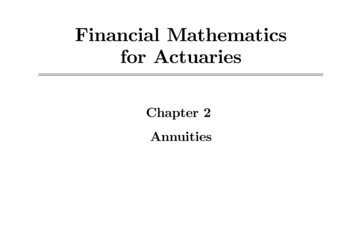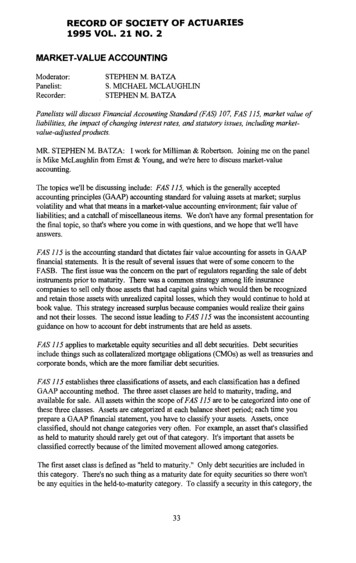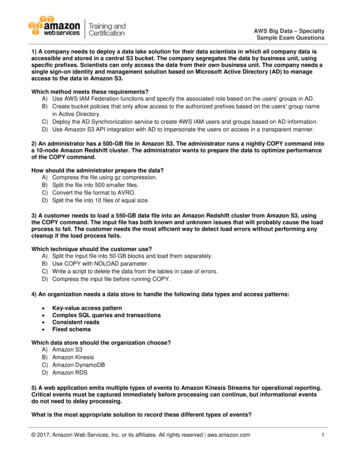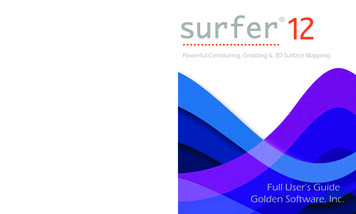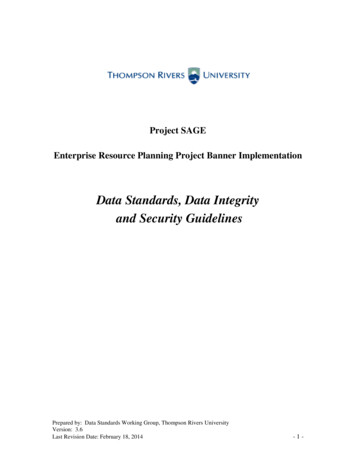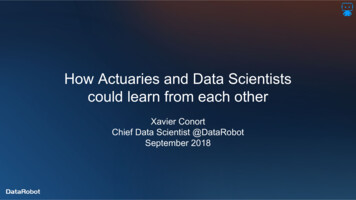
Transcription
How Actuaries and Data Scientistscould learn from each otherXavier ConortChief Data Scientist @DataRobotSeptember 2018
1991-1998:1999-2007:2008-2011:2011-2013:2013-now:
AGENDA What are GLMs and why do Actuaries like to use them? Why do Data Scientists prefer Machine Learning? and what do they fail tolearn from GLMs? Machine Learning initiatives, that successfully incorporate GLMs features How can Actuaries benefit from Machine Learning How to further improve Regularized Generalized Linear ModelsConfidential. Copyright DataRobot, Inc. - All Rights Reserved
What are GLMs and why do Actuarieslike to use them?
What Actuaries needsActuaries have to deal with Risks with severity that follows skewed distributionsRisks that tend to vary multiplicatively with rating factorsPricing constraints: pricing that is pro-rata to the policy durationcommercial discountssmall changes vs previous pricingRegulatory constraints: transparencyknown relationships between risk and risk factors example: risk expectation should always increase with the sum insuredWe will see that GLMs structure is very relevant to Actuaries needsConfidential. Copyright DataRobot, Inc. - All Rights Reserved
What are GLMsConfidential. Copyright DataRobot, Inc. - All Rights Reserved
GLMs variance functionIn practice, Actuaries use GLMs with a poisson (frequency modeling), gamma(severity modeling) or tweedie (cost modeling) distribution to deal with risk severitythat follows skewed distributions.By using a Gamma distribution, Actuaries inform the model that the expectedvariance increases with the square of the expected value of each observation.This is important because: This first reflects a reality: larger a risk is, larger its dispersion is. It second prevents Actuaries from overfitting observations with largevalues. Indeed more tolerance is given to the deviation of the observed value with its expected value ifthis expected value is high.Confidential. Copyright DataRobot, Inc. - All Rights Reserved
GLMs link functionLog link function is also very much used in practice by actuaries. This helps: ensure that predicted value is non negative build a model that takes into account the fact that most insurance risk varymultiplicatively with rating factorsImportant note: applying a linear model to the log of Y values (instead of a GLMwith a log link function) is not recommended as this leads to biased predictedvalues. Indeed, log(E(Y)) is different to E(log(Y)). If you do this, don’t forget toadjust your predictions or you will predict the median of the cost instead of themeanConfidential. Copyright DataRobot, Inc. - All Rights Reserved
OffsetOffset is an awesome feature that allows Actuaries to incorporate constraints orstrengthen their modelling strategy: they can ensure that predicted value is proportional to the exposure they can apply arbitrary discount to some part of the populationthey can include a priori effects derived from: other larger, similar productsmarket practiceprevious pricingthey can build a model in multiple stages: first stage will focus on primary features that are fully trustedsecond stage will capture the marginal effects of features that are less trusted and lesscommonly availableConfidential. Copyright DataRobot, Inc. - All Rights Reserved
Additional GLMs featuresSome actuaries use: splines to learn non-linearity binning to capture non-linearity those need to be manually defined and can computationally expensivebins should not be too small such that they contain enough statistical materialinteractions to learn complex relationshipsmixed models to handle categorical features with high cardinalityConfidential. Copyright DataRobot, Inc. - All Rights Reserved
Why do Data Scientists preferMachine Learning? Are they discardingGLM features too fast?
Data Scientists work with too many features for GLMsBuilding a GLMs is very time consuming. Actuaries need to manually check thestatistical significance of each factor (via p-values) and then remove theundesirable factors from the model. This is not practical in presence of largenumber of features or unstructured data such as text.Data Scientists prefer automated regularization embedded in MachineLearning algorithms.One of the most popular ML algorithms is the Regularized GLMs (a very closecousin to GLM!) where a penalty is added to the GLMs loss function. This forcesthe model to automatically shrink to 0 coefficients of undesirable factorsRegularized loss function GLM loss function If lambda2 is 0, it is a LASSO penalty. If lambda1 is 0, it is a RIDGE penalty. If none are zeros, it is an elastic-net penaltyConfidential. Copyright DataRobot, Inc. - All Rights Reserved
Data Scientists want to learn automatically complex signalData Scientists love Machine Learning (ML) algorithms that can automaticallycapture non-linearity and interactions between factors.This helps them be very productive and get strong accuracy without much effortwhile building a complex GLMs requires Actuaries strong familiarity with the data,significant effort and expertise.It is common to hear that ML helps speed up projects from X months to X weeks.With Automated ML (automated preprocessing, automated hyper-parameterstuning, automated model selection), this can be further reduced to X days or evenless.Popular ML algorithms that are good in catching complexity: Gradient Boosting Machine Random Forest Neural Network Support Vector MachineConfidential. Copyright DataRobot, Inc. - All Rights Reserved
GLMs features Data Scientists should know betterwellknownlittleknownBy discarding too fast GLMs from their toolbox, Data Scientists often fail to learnthe benefits that some GLMs features can offer: less risk to overfit large values thanks to the use of poisson, gamma,tweedie loss functions multiplicative structure thanks to the log link function that can help thealgorithm find more easily the signal ability to incorporate known effects, control bias or do boosting via theuse of offsetConfidential. Copyright DataRobot, Inc. - All Rights Reserved
Example of offset to control biasThe use of offset was critical in my solution to win the GE Flight Quest, acompetition where I had to predict flights delays in USA.I wanted the machine: to learn a flight is late because of bad traffic and badweather and not to learn that one airport will never have delaysin the future because there have not been any delayin this airport for the past 3 monthsTo achieve this, I used a 2 stages modeling (approach I learnt from actuaries!): first I fitted one GBM with features that I believed strongly related to delays then, I fitted one Regularized GLM with the GBM predictions as offset andother variables such as the name of the airport as featuresConfidential. Copyright DataRobot, Inc. - All Rights Reserved
Machine Learning initiatives, thatsuccessfully incorporate GLMsfeatures
XgboostConfidential. Copyright DataRobot, Inc. - All Rights Reserved
XgboostConfidential. Copyright DataRobot, Inc. - All Rights Reserved
Why Actuaries and Data Scientists should be excitedGradient Boosting Machine (implemented by xgboost) is a close cousin to GLMs.The only difference is: the design matrix X is not defined by the user but is a set of thousands ofrules found in a stagewise manner by the Machine. the coefficients beta are learnt slowly by the Machine. early stopping is used when accuracy improvements are too lowActuaries can apply GBM to their risk modeling in a very similar way to what theydo with GLMsOn the other hand, Data Scientists can add Actuaries tricks to their toolbox(exponential distributions, link function, offset.).Confidential. Copyright DataRobot, Inc. - All Rights Reserved
Other Machine Learning initiativesOffset supportXgboost (GBM), H20 (GBM, ElasticNet, NN), DataRobot (GBM, ElasticNet, SVM), R gbm, R glmnet(ElasticNet)Poisson supportfor claim frequenciesXgboost (GBM), LightGBM (GBM), H20 (GBM, ElasticNet, NN), DataRobot (GBM, ElasticNet, NN, SVM),R glmnet (ElasticNet), pyglmnet (ElasticNet)Gamma supportfor claims severitiesXgboost (GBM), LightGBM (GBM), H20 (GBM, ElasticNet, NN), DataRobot (GBM, ElasticNet, NN, SVM),pyglmnet (ElasticNet)Tweedie supportfor total claim cost (frequency x severity)Xgboost (GBM), LightGBM (GBM), H20 (GBM, ElasticNet, NN), DataRobot (GBM, ElasticNet, NN, SVM),Confidential. Copyright DataRobot, Inc. - All Rights Reserved
How Actuaries can benefit fromMachine Learning
Machine Learning (ML) benefits for ActuariesThanks to ML, Actuaries can Be more productive More use cases Benchmark existing models Explore faster new data to enrich existing solutions. Improve existing models structure thanks to ML insightsexplore new data valuethanks to ML feature impactHow can you improve existing models thanks to ML? learn optimal boundaries (from partial dependence plots) when you do binningto capture non-linearity add most impactful interactions found by ML improve modelling of categorical variablesChallenge: adding higher complexity to a GLM structure increases the risk ofoverfittingConfidential. Copyright DataRobot, Inc. - All Rights Reserved
Automated BinningLearn from xgboostPartial DependenceFind boundaries thatbest approximatethe xgboost PartialDependenceConfidential. Copyright DataRobot, Inc. - All Rights Reserved
Risk of overfitting a complex structureCreating (granular) bins from numeric features, adding levels of categoricalfeatures and adding interactions increase the risk of overfittingUnfortunately, using traditional (Ridge or Lasso) GLMs won’t help as informationon the ordinal nature of bins is lost. For small bins with little statistical information,the Ridge or Lasso penalty will fail to assign a value close to the coefficients ofadjacent bins.Predictions for thisbin seem very noisy.And there is too littledata to make thebin’s resultscredible.Confidential. Copyright DataRobot, Inc. - All Rights Reserved
How to reduce risk of overfitting of a complex structureHere is the solution I developed for DataRobot’s Generalized Additive Modelto reduce the risk of overfitting small binsInstead of fitting a GLM with Target complex model structure, offset O, link function L, distribution dI use a surrogate model as the strategy to combat overfitting.I fit first a GBM with the same target, offset, link function and distribution.Then fit a Linear Model with GBM margin predictions complex model structureConfidential. Copyright DataRobot, Inc. - All Rights ReservedResults look much lessnoisy.Indeed, GBM didn’tcapture the noise in thedata thanks toregularisation and theordinal nature of thefeature that is exploitedby GBM
Build your own surrogate model Fit your favorite ML algorithm: Learn from the algorithm’s insights for feature engineering: Apply the link function to the in-sample predictions of your ML algorithm (margin predictions)and use this as a targetFit a linear model with the features you derived from the ML insightsApply the inverse link function to the linear model predictionsFind interactions: feature impact to select factorspartial dependence plots for each factor to bin numeric features or decide on the formulaFit a “main effects” model Use one that supports link function, exponential distributions and offset if you need touse interactions reported by the ML algorithm if it exists (supported soon in DataRobot)or look for interactions that best explain the residuals between your “main effects” solution andthe predictions of your favorite ML algoFit selected interactions on the residualsConfidential. Copyright DataRobot, Inc. - All Rights Reserved
How to further improve RegularizedGeneralized Linear Models
This is an emerging hot topic in insuranceLast year during my visit in Japan, Iwasawa-san, a famous actuary in Japan,convinced me that the potential of Regularized Generalized Linear Models has notbeen fully exploited yet and Fused Lasso could be of great interest to Actuaries.Thanks to him, I discovered that Fused Lasso can allow data driven risk factorbinning, levels grouping and spatial (or interactions) modeling within a GLMframework and combat the risk of overfitting small bins!In the meantime, my brother in France shared with me very good slides fromBelgium actuarial researchers that say exactly the same Devriendt.pdfConfidential. Copyright DataRobot, Inc. - All Rights Reserved
According to the researchers, magic comes from new penaltiesUnfortunately, no implementation is available yet except for the R genlassopackage that supports only the gaussian distributionConfidential. Copyright DataRobot, Inc. - All Rights Reserved
Takeaways
TakeawaysData Science took time to embrace Actuaries practices.On the other end, Actuaries have resisted to Machine Learning innovations.We can now observe interest on both sides and that more Machine Learningalgorithms support features that are essential for Actuaries but also useful for DataScientists.More innovations are expected in the future.New approaches such as surrogate models and Fused Lasso are good examplesof emerging techniques that could change how both Actuaries and Data Scientistswork.Confidential. Copyright DataRobot, Inc. - All Rights Reserved
QuestionsConfidential. Copyright DataRobot, Inc. - All Rights Reserved
By discarding too fast GLMs from their toolbox, Data Scientists often fail to learn the benefits that some GLMs features can offer: less risk to overfit large values thanks to the use of poisson, gamma, tweedie loss functions multiplicative structure thanks to the log link function that can help the algorithm find more easily the signal ability to incorporate known effects, control bias or do .
